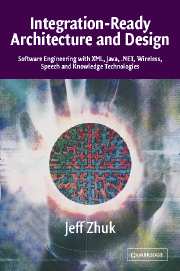 Integration-Ready Architecture and Design
Integration-Ready Architecture and Design Book contents
- Frontmatter
- Contents
- Preface
- Contributors
- Acknowledgments
- Introduction
- Notes for Educators: AMA Teaching Methods
- Chapter 1 Collaborative Engineering
- Chapter 2 Software Architecture and Integration Technologies
- Chapter 3 From a Specific Task to “Integration-Ready” Components
- Chapter 4 Integration with Voice
- Chapter 5 An Introduction to Knowledge Technologies
- Chapter 6 Write Once
- Chapter 7 The New Generation of Client–Server Software
- Chapter 8 Wireless Technologies
- Chapter 9 Programming Wireless Application Protocol Applications
- Chapter 10 A Single JavaCard Identity Key for All Doors and Services
- Chapter 11 The J2ME Family
- Chapter 12 Speech Technologies on the Way to a Natural User Interface
- Chapter 13 Integration with Knowledge
- Chapter 14 Distributed Life in the JXTA and Jini Communities
- Appendix 1 Java and C#: A Saga of Siblings
- Appendix 2 XML and Web Services
- Appendix 3 Source Examples
- Index
Appendix 2 - XML and Web Services
Published online by Cambridge University Press: 17 August 2009
- Frontmatter
- Contents
- Preface
- Contributors
- Acknowledgments
- Introduction
- Notes for Educators: AMA Teaching Methods
- Chapter 1 Collaborative Engineering
- Chapter 2 Software Architecture and Integration Technologies
- Chapter 3 From a Specific Task to “Integration-Ready” Components
- Chapter 4 Integration with Voice
- Chapter 5 An Introduction to Knowledge Technologies
- Chapter 6 Write Once
- Chapter 7 The New Generation of Client–Server Software
- Chapter 8 Wireless Technologies
- Chapter 9 Programming Wireless Application Protocol Applications
- Chapter 10 A Single JavaCard Identity Key for All Doors and Services
- Chapter 11 The J2ME Family
- Chapter 12 Speech Technologies on the Way to a Natural User Interface
- Chapter 13 Integration with Knowledge
- Chapter 14 Distributed Life in the JXTA and Jini Communities
- Appendix 1 Java and C#: A Saga of Siblings
- Appendix 2 XML and Web Services
- Appendix 3 Source Examples
- Index
Summary
Though derived from SGML (Standard Generalized Markup Language), Extensible Markup Language (XML) [1] quickly outgrew its initial purpose of enabling large-scale electronic publishing and became the main road of data exchange over the Internet and elsewhere. XML is simple and flexible. These qualities have made XML the perfect instrument for creating new languages in many areas.
For example, HTML is currently the most common language used to create Web pages according to orthodox Web technology, in which the client program is a Web (HTML) browser. However, HTML has its limitations: HTML tags are predefined and cannot be changed or extended.
XML EXTENDS THE WEB AND BUILDS A PLAYGROUND FOR ITS CHILDREN
XML, on the other hand, allows us to create our own elements, attributes, and structures to describe any kind of data. With such flexibility, XML provides the ideal solution for producing new languages to express the ever-increasing complexity of data exchange and other needs.
WAP (Wireless Application Protocol) is, in a way, a child of web technology; but WAP has slightly different requirements, which are not covered by HTML tags. A member of the XML family, WML (Wireless Markup Language) provides the necessary keywords to satisfy these requirements.
XML DESCRIBES BUSINESS RULES AND DATA STRUCTURES; XSLT AND X PATH DESCRIBE THEIR TRANSFORMATIONS
XML is becoming the main tuning tool to describe business rules, data structures, and their transformations.
Extensible Stylesheet Language (XSL) [2] is another member of the same big family of languages.
- Type
- Chapter
- Information
- Integration-Ready Architecture and DesignSoftware Engineering with XML, Java, .NET, Wireless, Speech, and Knowledge Technologies, pp. 539 - 550Publisher: Cambridge University PressPrint publication year: 2004
